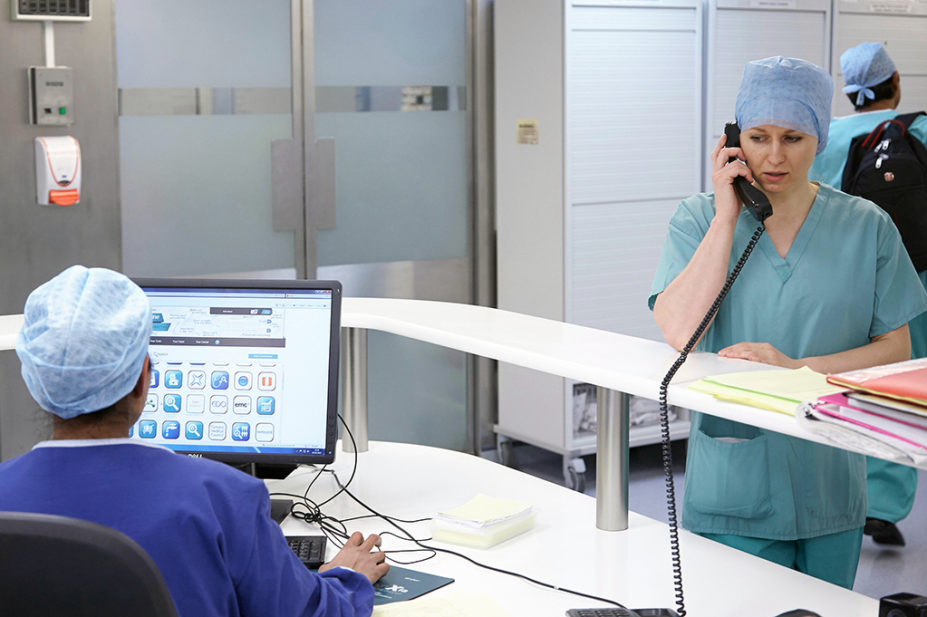
David Curtis / Alamy Stock Photo
Setting up electronic prescribing systems in NHS hospital trusts has, so far, taken 30 years and counting.
Although the first electronic prescribing and medicines administration (ePMA) systems rolled out in the early 1990s, the government’s latest push to expedite the process came in February 2018, when former health secretary Jeremy Hunt committed £75m “to help hospitals progress” with setting up ePMA systems. The first batch of this funding, totalling £16m, was later doled out to 13 hospital trusts in England in November 2018. A further £16m was shared out to 16 hospital trusts in England in November 2020.
The systems replace handwritten prescriptions, paper medicines charts and ward-based medication trollies, in favour of one process that enables clinicians to prescribe, review, administer and order medicines from a computer.
For patients, visible evidence of an ePMA system will vary from one trust to the next. Those in Lincolnshire will see ‘workstations on wheels’ that allow staff to take the system to patients’ bedsides, a nursing station or anywhere on the ward, while those in East Sussex will find computers replacing traditional medication trollies on wards with patients instead administered medication stored securely by their bed.
But, universally, the primary aim is to reduce medication errors and the harm they cause to patients. Researchers have estimated that more than 237 million medication errors are made in England each year, costing 1,708 lives and nearly £98.5m annually.
To alleviate the problem, the government set up a working group in September 2017, which included representatives from the Care Quality Commission, and the Department of Health and Social Care’s acute care and quality and acute care and workforce directorates, to advise and report on what needed to be done to reduce this error rate in the NHS. Accelerating the implementation of ePMA systems in hospitals, following “robust evidence of clinical and cost effectiveness”, was one of the main priorities that they recommended.
The report, published in February 2018, cited research that looked at 25 studies that analysed the effects of ePMA systems on medication error rates and found that 23 studies showed a significant relative risk reduction of between 13% and 99%. Meanwhile, 6 of the 9 studies that looked into the effects on potential adverse drug events showed a significant relative risk reduction of between 35% and 98%.
Trusts that have implemented ePMA systems also mention benefits, including fewer missed medication doses, more timely requests for medicine supply and fewer prescribing incidents in patients with allergies. For pharmacy staff, the system means drug charts are always accessible, medicines reconciliation documentation is more efficient and it is easier to document medicine supplies.
However, the working group’s report also noted that hospital ePMA systems “are possibly one of the most challenging digital health systems to implement in provider organisations”, estimating that setting up such a system would take “typically 18 months to two years from conception to implementation”.
But — nearly four years on — responses to freedom of information (FOI) requests, submitted to The Pharmaceutical Journal from 11 of the 13 early adopter trusts that received the first tranche of funding in 2018, reveal that less than half have fully implemented an ePMA system. When the funding was handed out it had been expected “to speed up the implementation of ePMA across all trusts within the next three years to 2021”.
The slow rollout could be creating additional risks to patient care.
There are risks in having a hybrid situation where you’ve got some areas [of the trust] on paper prescribing and some areas on electronic
Bryony Dean Franklin, medicines safety and technology researcher at the University College London School of Pharmacy
“You probably want to minimise the amount of time where you’ve got a hybrid situation,” says Bryony Dean Franklin, a medicines safety and technology researcher at the University College London School of Pharmacy.
While there are risks to rushing out a new computer system in a “big bang” launch, “there are risks in having a hybrid situation where you’ve got some areas [of the trust] on paper prescribing and some areas on electronic,” she says.
“Staff moving between the two are going to have to be able to use both systems, but also patients moving between the two are going to have to be transcribed on and off each system as they transition, and I think any of these transitions carry risks.”
Ramandeep Kaur, chief clinical information officer at NHS University Hospitals of Northamptonshire NHS Group, says the hybrid approach taken by some trusts is one of several issues facing ePMA implementation.
She says she has seen surgical wards where “you’ll have them doing the preoperative stuff on ePMA, the intraoperative stuff on paper, and then they come out and do the postoperative stuff back on ePMA — but that’s a risk in itself”. The Healthcare Safety Investigation Branch (HSIB) made a similar warning in 2019 following an investigation into the death of a woman aged 75 years, who was dispensed two anticoagulant medicines, which she took simultaneously, after being discharged from hospital.
The incident occurred, in part, because of a failure to transcribe the patient’s existing medicine from paper records held by the emergency department into the trust’s ePMA system. As a result, the HSIB advised that the “use of paper and electronic systems in parallel should be minimised to reduce the risk of error caused by multiple data entry/retrieval sources”.
When asked to comment on why their ePMA implementation processes are taking longer than expected, the early adopter trusts gave a variety of reasons.
For example, a spokesperson for East Kent Hospitals University NHS Foundation Trust, which received £1.45m from the government, suggested the rollout of the ePMA system was tied to “a wider implementation of an updated electronic patient record system”, adding that “ePMA is due to launch during the next phase of the rollout”.
Humber Teaching NHS Foundation Trust, which received the smallest cut of the ePMA funding in 2018 at £300,000, says the money that was provided did not cover the system’s rollout to all areas of the trust, such as its mental health community services. Instead, the trust is continuing to progress implementation “with internal resources”.
“The funding we received for ePMA was for our inpatient mental health services [which] use Lorenzo ePMA. This was fully rolled out [in] June 2020.”
We had the [COVID-19] vaccination programme to contend with, we had the monkeypox [virus] … so there were competing priorities in the NHS, which meant that ePMA was something less of a priority to focus on
Roger Fernandes, director of pharmacy at King’s College Hospital NHS Foundation Trust and interim chair of the Royal Pharmaceutical Society’s hospital advisory group
Roger Fernandes, director of pharmacy at King’s College Hospital NHS Foundation Trust and interim chair of the Royal Pharmaceutical Society’s hospital advisory group, describes the slow uptake as “astonishing” but says the most common reason is likely to be three years’ worth of “competing priorities” for trusts.
“We had the [COVID-19] vaccination programme to contend with, we had the monkeypox [virus], we had COVID patients in our beds that we had to contend with, so there were competing priorities in the NHS, which meant that ePMA was something less of a priority to focus on,” he says.
Fernandes adds that it has only been over the past six months that trusts have been able to start taking projects such as ePMA forward again. “That’s pretty much been the same for most London trusts, if not most trusts across the nation,” he says.
East Sussex Healthcare NHS Trust received £1.7m in 2018 to set up an ePMA system but says it has yet to complete implementation because of the COVID-19 pandemic.
“We took the decision not to rush the implementation of ePMA to make sure that our colleagues could continue to engage with the project despite the additional pressures they faced during the COVID-19 pandemic,” a spokesperson says.
“The result has been that we have now delivered the system across a number of key services at the trust, with the final phase of implementation scheduled to complete by the end of this year.”
For those trusts that did persevere with ePMA system implementation plans, the COVID-19 pandemic posed unique problems. Writing in The Pharmaceutical Journal in January 2022, Rushika Patel, an ePMA and specialist pharmacist in infection and immunity at Barts Health NHS Trust, which received £1.7m in the 2018 funding round, said that “rapidly changing guidance” in response to the virus “led to a large influx of clinical specialties demanding specific new drugs and care plans be built into the ePMA system in the middle of implementation”.
“So, alongside managing the pressures of implementation, we were also continuing to build the system at the same time,” she said.
Ultimately, the trust set up an ePMA system for all adult inpatient areas on 3 December 2021, but a spokesperson for the trust said it is still progressing with its implementation plans and “will complete the rollout by extending to paediatric and maternity units” in 2022.
Elsewhere, trusts say issues with ePMA software are causing a slower rollout. A spokesperson for Buckinghamshire Healthcare NHS Trust says the trust used the £1.62m in ePMA funding from the government “to make digital developments and purchase the necessary hardware, and we are currently reviewing our software options”.
“There have been challenges in adopting the system we chose into our wider trust network, which is why a full review is being undertaken before we can take further steps in implementing ePMA.”
Where ePMA systems have been fully implemented, however, the evidence suggests it is working well.
The five hospital trusts that responded to The Pharmaceutical Journal’s FOI request to say that they had fully implemented the system, as of July 2022, reported significant decreases in medication errors and thousands of pounds in cost savings as a result (see Box).
How have staff and patients benefited from electronic prescribing and medicines administration systems?
An audit of the ePMA system at Northern Lincolnshire and Goole NHS Foundation Trust showed that the number of actual errors dropped from 0.46 per patient (139 errors relating to 299 patients) in October 2019, before the system was set up, to 0.37 per patient (71 errors relating to 189 patients) in March 2021, post-implementation.
Paulash Haider, assistant chief pharmacist at the trust, says the system “has transformed the way we prescribe and administer drugs”.
“We now have a clear record of who has prescribed what drug, at what dose, which are all now auditable at a glance. We have seen a reduction in the number of medication errors since we implemented ePMA and other benefits include the ability to cross-check for any drug interactions and to clearly see any allergies.
“Doctors tell us it makes their ward rounds much easier and, for nurses administering the drugs, they’re not having to contend with illegible handwriting on a paper chart.”
Meanwhile, an internal audit drawn up by East London NHS Foundation Trust calculated that its ePMA system saves the trust £916,058 per year, including £34,020 through reducing medicine prescribing errors and £52,125 by reducing medication administration errors.
There has been a “reduction in the number of errors linked to administration, dispensing, prescribing and transcribing post EPMA by 47%, 45%, 43% and 70%, respectively, across relevant directorates”, the audit says, adding that “the total number of medication errors overall have reduced by 42%”.
Mid Yorkshire Hospitals NHS Trust, which saw its ePMA system go live in January 2020, said that the system has improved safety by using “pre-built protocols to aid decision-making”.
“Drug charts are now legible thus allowing the safe administration of the right medicine to the right patient at the right time. Drug charts are always accessible as there is no longer a need to send charts to pharmacy; there is a simple method for nurses to request medicines; medicines reconciliation documentation is quicker and more efficient; it is easy for pharmacy to document medicine supplies; and there is a clear audit trail of patients’ medicines journeys, thus making investigation of patient clinical incidents easier,” a spokesperson says.
“For patients, it means fewer missed doses of critical medicines, improved timeliness of medicine supply requests, fewer prescribing incidents in patients with documented allergies, and standardised prescribing using quick lists and protocols which thus reduces the risk of prescribing errors.”
Mid Yorkshire Hospitals NHS Trust, which received £1.6m from the government to set up its system, which it completed in January 2020, said its “key to success” had been “high-profile clinical leadership at executive director level”, with ward areas that “were very open to change”.
“This culture of embracing and adapting to change across the trust was enabled and driven by preparatory groundwork undertaken during pre-implementation to understand the impact, requirements and challenges that colleagues would face,” a spokesperson says.
It’s a message that has yet to reach all corners of secondary care and suggests there may be more deep-seated barriers to implementation, aside from day-to-day capacity issues. “These projects have to be clinically-led,” says Kaur, who also wrote her master’s thesis on ePMA implementation.
“Quite often they’ve been seen as pharmacy-led or IT-led projects, and there needs to be that shift in culture change — that it involves everybody in the organisation,” she says, clarifying that the project should be led by a multidisciplinary team of clinicians, not just doctors.
“The problem is that, obviously, pharmacy staff have lots of expertise in these areas. But now in my role as the chief clinical information officer, I’m very keen to say that this is not a pharmacy-led project, this is a clinically-led project, and have we got the right resources and the right people around the table to deliver that?”
You might not have every drug on there, but for all the drugs you have on the system, it has to be electronic, otherwise it’s going to be a mess
Brian Power, lead informatics pharmacist at Wirral University Teaching Hospital NHS Foundation Trust
Brian Power, lead informatics pharmacist at Wirral University Teaching Hospital NHS Foundation Trust, which was one of three areas to set up an ePMA system in the early 1990s, says that, even if implementation is “a trust project, who do you get as your leaders for it, can they push people?”
“The bottom line is, when you go live with something like this, you can’t — well, you can but it’s risky — start running paper and electronic systems together.
“You might not have every drug on there, but for all the drugs you have on the system, it has to be electronic, otherwise it’s going to be a mess.”
While the leadership in some NHS trusts continue to grapple with an IT system that first came to fruition 30 years ago, patients on the wards are still being put in harm’s way. In 2018, when around 25% of hospitals had the systems in place, former health secretary Jeremy Hunt warned that “between four and five people die every single day” because of medicine-related error.
A year later, the NHS told The Pharmaceutical Journal that just 35% of acute trusts in England were live with ePMA at the time.
Neither NHS England nor the Department of Health and Social Care responded to requests for an update on progress with implementation. But with the worst of the pandemic in the rear-view mirror, and the ePMA success stories of a select few trusts, there’s little reason why this slow-moving rollout can’t pick up pace.
You may also be interested in

Reviewing prescribing practice in an adult critical care unit with a newly implemented electronic prescribing system
